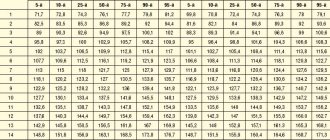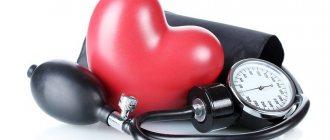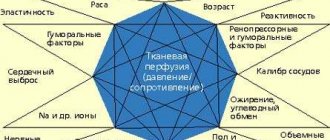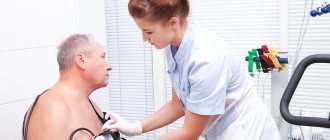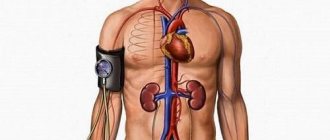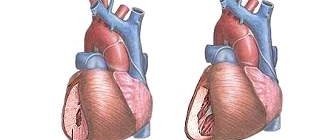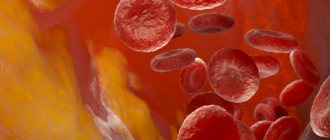5 / 5 ( 1 voice )
Stable blood pressure, as a functional process, is involved in ensuring the vital functions of our body. Normally, the functioning of the heart and vascular system will be good.
If it is known that a person has high or low blood pressure, then treatment is aimed at normalizing it. But sometimes it rises spontaneously to levels above 140/100 mmHg. Art., then decreases on its own and becomes normal. Then such pressure is called labile, i.e. unstable, moving, temporary or changing. The human condition itself is called labile arterial hypertension.
Lability of blood pressure, what does it mean?
Labile blood pressure is not an independent disease, but a symptom, since it manifests itself against the background of any pathologies and can become the basis for the development of hypertension. If pressure surges occur frequently, then this variable blood pressure can be considered the initial stage of the development of hypertension.
When there is a sharp jump in pressure, the vessels experience severe stress
Rare spontaneous pressure fluctuations of 10 mm Hg. is not considered a pathology in people who have increased physical activity at work or in sports, and in people dependent on changes in weather, i.e. weather dependent. But higher fluctuations in readings must be taken seriously, since the pulse also becomes unstable, i.e. Heart rate becomes high.
In this case, the vessels, especially the eyes, will experience enormous stress, which leads to the onset of pathological processes in the walls, a decrease in the elasticity of arteries, veins and microvessels. Labile hypertension quickly develops into arterial hypertension, and spontaneous increases in blood pressure are no longer normalized to normal levels without the use of medications.
In order to prevent serious chronic pathology, it is important to consult a doctor in the early stages to examine the body in order to identify the causes of this symptom and take appropriate measures in a timely manner.
Symptoms
Emotional instability with lability of blood pressure
With sharp increases in blood pressure in patients, the following conditions are typical:
- a headache suddenly begins to ache, often in the forehead or back of the head;
- irritability increases and emotions become unstable;
- memory deteriorates, attentiveness and learning ability decrease;
- sleep is disturbed, difficulty falling asleep;
- “flies” or “rainbows” flash before the eyes;
- limbs go numb and burn.
In people: young or old, the quality of life decreases with a steady progression of such symptoms.
Characteristic symptoms
A sharp increase in pressure is manifested by the following signs:
- difficulties with breathing (shortness of breath, inability to take a full breath, dizziness);
- sense of anxiety;
- noise and ringing in the ears;
- heart rhythm disturbances (frequent contractions and the feeling of your own heartbeat in the ears);
- rush of blood to the face and neck;
- pain in the temples and the back of the head.
Many patients, at the moment of an unexpected increase in pressure, feel panic, irritability, and complain of numbness in the limbs. Hand trembling, inability to concentrate on work, decreased alertness and a feeling of fatigue may also be recorded. Such symptoms are more typical for a pressure surge above 150 mmHg.
In order not to miss the development of labile hypertension, you should regularly measure your blood pressure at home using a tonometer. Elevated levels, which independently return to normal after 1–1.5 hours without taking antihypertensive drugs, indicate the initial stage of the disease and require consultation with a specialist.
Causes of blood pressure lability
Lability of blood pressure occurs against the background of:
- symptomatic (secondary) arterial hypertension , it is distinguished from hypertension, since other pathologies periodically increase blood pressure numbers, for example, an adrenal tumor or pheochromocytoma;
- vegetative-vascular dystonia , since the nervous regulation of the vascular bed is disrupted;
- diabetes mellitus due to multiple neuropathies and angiopathy, damage to the vascular bed and its innervation, while the slightest effects disrupt the functioning of the vascular system and make blood pressure changeable;
- obesity , which leads to atherosclerosis, arterial hypertension and blood pressure variability.
Physical inactivity and poor nutrition lead to obesity and blood pressure fluctuations
Pressure surges occur as a result of psycho-emotional stress on the body, stress, anxiety and lack of sleep, lack of physical activity, physical inactivity, poor nutrition, bad habits: smoking, alcohol abuse, caffeinated drinks, salty foods with high sodium levels. Senile age and hereditary predisposition, male and female menopause, hypercalcemia are also included in the list of factors that increase blood pressure.
Problems with pressure drops
Spontaneous changes in blood pressure lead to the following complications:
- hypoxic starvation - oxygen deficiency, which causes pathological changes in the brain and destructive changes in the heart, kidneys, and limbs;
- chronicization of the process - the labile form of blood pressure turns into chronic arterial hypertension.
Due to spasm of blood vessels, they sharply narrow, blood flow becomes difficult and pressure on their walls increases, and the organs do not receive adequate nutrition and fresh oxygen. With the loss of elasticity and the appearance of fragility of blood vessels, their permeability increases, and cholesterol plaques form on the walls.
Drowsiness and loss of strength due to sudden surges in blood pressure and lack of nutrition in the blood
In the video in this article you can learn about labile pressure:
Adolescents, women on the eve of menopause and pregnant women, due to hormonal instability, experience labile, unstable blood pressure, since hormones affect vascular tone.
Labile arterial hypertension in children and adolescents: causes
This type of hypertension is often found in children and adolescents. It is characterized by the fact that during the day the child’s blood pressure readings are close to normal, and in the morning and afternoon they increase slightly. The causes of the disease are hemodynamic, genetic, neurohumoral:
- change in systolic pressure within the limits allowed by age;
- excess body weight;
- endocrine diseases;
- problems with the cardiovascular system;
- kidney disease;
- pathology of the endothelium - the cellular layer lining the internal cavity of the heart.
Diagnostics
When examining the body, the following is carried out:
- ECG, echocardiography;
- Ultrasound of the heart muscle, thyroid gland, kidneys;
- vascular scanning;
- general and biochemical blood test;
- general urine analysis.
Unstable blood pressure due to hormonal changes
To ensure the reliability of the data, daily blood pressure monitoring is prescribed. Measurements are performed at least 20 times a day, and a graph is drawn up indicating all noticeable fluctuations in indicators.
If repeated high readings above 140/90 mmHg are observed. Art., then labile hypertension is diagnosed. In hypotensive patients, indicators are considered abnormal from 120/80 mm Hg.
Treatment
Treatment includes:
- drug therapy for underlying underlying diseases that provoke labile arterial hypertension;
- symptomatic therapy with diuretics, potassium antagonists, α1-blockers (for example, Alfuzosin, Doxazosin, Prazosin, Silodosin, Tamsulosin, Terazosin, Urapidil) to stabilize blood pressure;
- prevention, which consists of following a diet, switching to a healthy lifestyle: playing sports and swimming, giving up bad habits.
To rule out hypertension, cardiologists often prescribe medications such as Phytolife and Normio. They normalize blood pressure, eliminate palpitations and headaches, improve sleep and add energy during the day.
Natural remedy for hypertension
Means for normalizing blood pressure
To cope with blood pressure lability, you need to follow a daily routine, avoid stress, and allow your body to cope with stress through proper sleep - 8-10 hours a day. If nervousness is present, then you need to drink a few drops of motherwort or valerian tincture and other medicinal plants. Instructions for these natural remedies are on the packaging.
Pharmacy tinctures and drops to relieve stress and improve sleep
To prevent the development of heart and vascular diseases and pressure surges, you need to use an elixir from pharmacy tinctures. You can make this cocktail yourself at home.
You need to mix alcohol tinctures in a dark glass container:
- 100 ml each - hawthorn, motherwort, valerian, peony;
- 50 ml – eucalyptus;
- 25 ml - mint.
Add 30 ml of Corvalol and 10 cloves to the mixture and close the container with a lid or stopper. This elixir is infused for 2 weeks in a dark cabinet and shaken periodically.
A cocktail of infusions is drunk with a glass of water.
Take this way: add 30 drops to 100 ml of water and drink 30 minutes before meals 3-4 times a day for 30 days. It is advisable to take the last dose before bedtime. After a week's break, the course of treatment can be repeated. Stop taking the elixir when you feel well.
The combination of valerian, hawthorn and motherwort is necessary to improve cerebral circulation, eliminate the consequences of stroke, heart attack, prevent the formation of thrombosis, and improve hematopoiesis. A trio of such herbs in alcohol or Tricardin can be purchased at the pharmacy.
The expected effect is obtained due to medicinal substances present in alcohol in dissolved form. In this form, they are absorbed faster and immediately begin to act.
The video provides instructions for a homemade cocktail to normalize blood pressure during spontaneous surges:
How do medicinal herbs work in tinctures?
- Motherwort. Motherwort gives off its alkaloids, glycosides, bitterness, bioflavonoids, mineral salts and vitamins to support the nervous system and the entire body as a whole. The heart function improves and the heart rate normalizes, nervousness and insomnia go away, vasospasm and headaches are relieved. Blood circulation is activated, therefore the supply of nutrition and oxygen to the main organs is improved, which eliminates spontaneous increases in pressure and hypertension at the initial stage.
- Valerian. Valerian root is beneficial essential oil with active ingredients and valeric acid. The tincture helps to quickly fall asleep and restful sleep, reduce nervous excitability, eliminate migraines, and neuroses of the cardiovascular system. Due to the antispasmodic effect, muscle tension in the internal organs is eliminated.
- Hawthorn. It is considered an excellent herbal healer for cardiac disorders. Its components are necessary for restoring cardiac and cerebral circulation, toning the myocardium, eliminating tachycardia, high blood pressure and palpitations, and atherosclerosis. And also for improving and calming the nervous system: reducing irritability, nervousness, eliminating insomnia.
- Peony. Peony root is rich in macro- and microelements, glycosides, organic acids, essential oils, salicylic and benzoic acids, starch, tannin and alkaloids. Its sedative properties help the body produce endorphins, increase its vitality, improve mood, and strengthen overall health. Since the plant is poisonous, it is impossible to exceed the dosage specified in the instructions.
- Eucalyptus. The tincture is saturated with tannins, ellagic acid, flavonoids, resins, waxes, essential oils with terpene compounds and the main component - cineol monocyclic terpene. Eucalyptus has antiseptic, anti-inflammatory and disinfectant properties. In addition, the tincture relieves mild forms of neuroses, neurasthenic disorders, and eliminates insomnia.
- Mint. Peppermint tincture is a universal remedy, it soothes, relieves pain, dilates blood vessels, acts as an antibiotic, tones, has a choleretic and diuretic and other effects, relieves nausea and vomiting. In 100 g of mint, in addition to water (79 g), there are a lot of proteins, carbohydrates, fiber, fats, saturated fatty acids, microelements: K. Ca, Mg, P, Na, Fe, vitamins: group B, C. Mint leaves are rich in the glycoside tropsoline , essential oil with sulfur, phytosterol, potassium sulfate, the enzyme myrosin, ascorbic acid, sugar and starch, pectin and sorbuzin pigment. The inflorescences contain up to 6% essential oil, the seeds contain 20% fatty oil, and mint oil contains a lot of menthol and its esters with acetic and valeric acid, and other components: limonene, dipentene, carvone and citral.
- Corvalol. A pharmaceutical preparation based on the ethyl ester of α-bromoisovaleric acid is able to relieve vascular spasms. Phenobarbital in its composition calms, improves sleep, and acts as a mild tranquilizer. Peppermint oil has a sedative and antispasmodic effect. With the help of Corvalol, irritability, neurosis, and vascular spasms in vegetative-vascular dystonia are reduced.
- Columns of cloves. Thanks to the antiseptic and analgesic, tonic, sedative, antiviral, diuretic and diaphoretic, antispasmodic, antimicrobial and wound-healing effects of cloves, it began to be used in medicine. Namely: to normalize blood pressure, eliminate gastrointestinal pathologies, fight cancer, dental and gynecological diseases, and for cosmetics.
Dried cloves are used for spontaneous increases in blood pressure
Contraindications to the use of elixir from tinctures
The above tinctures in the elixir (cocktail) complement each other. They enhance the interaction with blood pressure lability, chronic stress conditions or depression, apathy and nervous disorders, insomnia and irritability.
The components in the solution are the first helpers for blood vessels and heart muscle. But besides these advantages, they also have contraindications. The cocktail should not be taken by women during pregnancy and breastfeeding, children under 12 years of age, persons with digestive diseases, allergies and alcoholics.
Medicinal teas
Teas with hops, mint, oregano, valerian root, and chamomile are beneficial for the body. Dry raw materials in equal parts by weight are crushed and 40 g of the collection are steamed with boiling water (0.5 l) in a teapot.
Infuse tea under a lid and a fur coat for half an hour and drink 0.5 cups half an hour before meals, i.e. 100 ml each. If all the components are missing, then you can add 1.5 tsp to 100 g of mint. one of the components, then steam as above.
Medicinal teas to normalize blood pressure and general health
Blood pressure lability: what is it and how does it manifest?
Instability or lability of blood pressure, not everyone knows what it is, despite the fact that such a disorder occurs quite often. The condition is characterized by periodic surges in blood pressure above 140 mmHg.
The peculiarity of pressure lability is that this disorder does not depend on age and can occur in both young and elderly people.
Treatment options
To prevent lability from developing into hypertension, the following treatment methods are used:
- Remedies for the main problem. Is lability caused by excess weight? The doctor will prescribe a diet. The problem is cervical osteochondrosis? He will refer you to a neurologist, who will prescribe physiotherapy and therapeutic exercises. Is it all heart disease? They will be prescribed appropriate medications and, if necessary, an implant will be placed.
- Symptomatic treatment. Diuretics, potassium antagonists, adrenergic blockers are drugs that do not help get rid of lability, but allow you to keep it within limits. Diuretics reduce the amount of water in the body, while other drugs reduce blood pressure. Additionally, agents can be used to prevent thrombosis, to increase the amount of oxygen in the blood, and to restore blood vessels.
And the main treatment is measures to correct the lifestyle, which led to the emergence of lability. They coincide with the measures that a person who wants to prevent problems with blood pressure should take.
Getting your lifestyle in order always follows the same pattern. You need to adjust your diet:
What it is?
Lability of blood pressure (BP) is a very dangerous pathology, which is fraught with a huge number of different complications.
Its most dangerous manifestation is that alternating arterial hypertension and hypotension cause disruption of the blood supply to the neurotissues of the brain.
At the same time, there is no periodicity in changes in blood pressure values - fluctuations can occur at least every hour, at least once a week; High blood pressure, just like low blood pressure, is permanent or temporary.
Labile arterial hypertension in most cases is a rapidly passing condition, accompanied by an increase in blood pressure above 140 per 100 and a drop below 60. Fluctuations within the established norm rarely lead to clinical disorders, but sometimes such cases occur.
The peculiarity of pressure lability is that this disorder in no way depends on age and can occur in both young and elderly people (but in the former, this manifestation is usually associated with neuro-circulatory dystonia). Labile arterial hypertension requires careful attention and treatment - positive health dynamics are observed only in those patients for whom a multidisciplinary approach was applied.
Despite this, in the vast majority of cases, the pressure does not increase or decrease to critical values (maximum - the gap between values reaches 60 mmHg) and independently normalizes after a short period of time, the vessels experience severe stress (with a larger difference, there is a high probability manifesto of cardiovascular accidents).
But even with a small but constant adverse effect on the vascular bed (both hematomicrocirculatory and main), pathological processes in the walls will begin over time, resulting in excessive elasticity of the arteries and vessels. In turn, these histological transformations cause the progression of the disease and an increasing increase in pressure. With a long-term uncontrolled course, labile arterial hypertension can develop into either resistant arterial hypertension, in which high blood pressure does not return to normal without the use of more than 3 medications.
Nevertheless, the statistics are favorable - pressure lability turns into persistent resistant hypertension, which is resistant to drug treatment, in no more than 20% of people with unstable blood pressure.
Despite this, in the vast majority of cases, the pressure does not increase or decrease to critical values (maximum - the gap between values reaches 60 mmHg) and independently normalizes after a short period of time, the vessels experience severe stress (with a larger difference, there is a high probability manifesto of cardiovascular accidents).
Medicines
If labile blood pressure is a symptom of hypertension, endocrine and other pathologies, then the doctor prescribes medications individually according to the symptoms.
Remedies for high heart pressure
For arterial hypertension and hypertension, drugs from the sartan group are effective due to their high therapeutic effect.
Hypertension drugs
For example, for hypertension, treatment is prescribed:
- Losartan, Valsartan, Cardosal, Candesartan, Eprosartan - as angiotensin receptor blockers or sartans;
- Artesin, Doxazosin, Terazosin, Proxodolol, Urorek - α-adrenergic blockers;
- Zocardis, Kizinopril, Captopril, Prestarium - ACE inhibitors (angiotensin-converting enzyme);
- Veroshpiron, Indapamide, Torasemide, Furosemide - diuretics (diuretics);
- Amlodipine, Verapamil, Diltiazem - calcium antagonists.

